#Serfilippi
Note
Wait, Peggy was tutoring Hamilton's kids?
Twitter thread from Schuyler Mansion
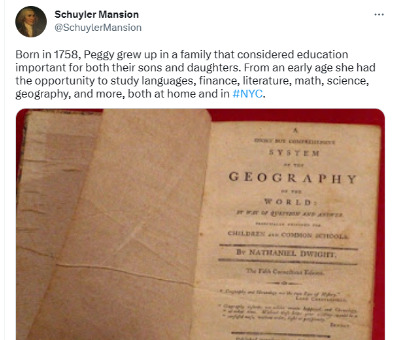
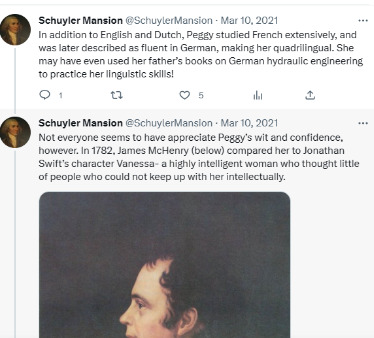

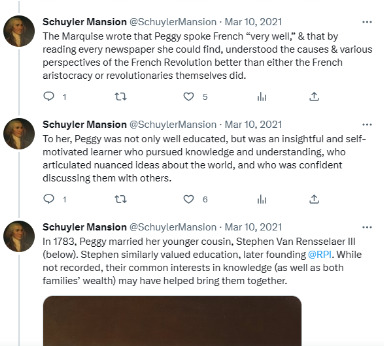
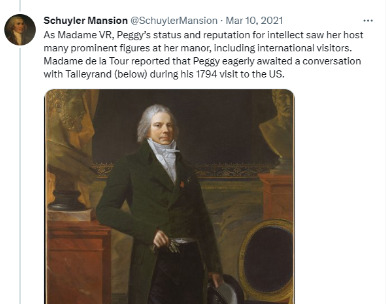
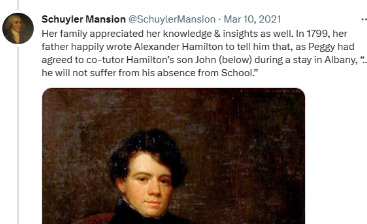
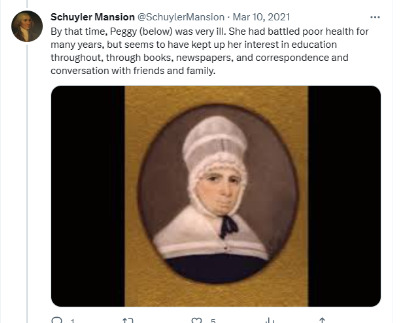

The letter from Philip Schuyler is from 6June1799.
I hope My beloved Eliza is in better health than when we left her, perswaded that a change of air would benefit her we entreat her to come up as Speedily as possible, and to bring at least the two Youngest children with her, Johnny will be Attended to by his Aunt and myself, and from his own avidity to acquire information he will not suffer from his absence from School.
Considering both the periods when various Hamilton kids spent month(s) with their grandparents in Albany, and the times Aunt Peggy (and her husband) stayed with the Hamiltons in NY, I don't think it's unlikely that she had some role at times in the education of the other Hamilton children, too.
The last link in the thread is to an article by Serfilippi on the education of Catharine VR Schuyler Malcolm Cochran that includes a few mentions of the education of the three oldest Schuyler sisters, including that they were in part educated in NYC with their parents back in Albany and Saratoga. There are some hints that both Angelica and Peggy may have received a longer period of tutoring than Eliza, or records are just missing. (It's also been noted by one old source that mom Catharine VR Schuyler was highly educated compared to Dutch women of her class, and knew English ways and all, too). Either way, the Schuylers took all of their children's educations very seriously and we know from other letters and diaries that Philip Schuyler had very high expectations for the learned knowledge of his last two daughters - I doubt he expected less for his first three.
7 notes
·
View notes
Text
Urbino, chi erano le vittime dello scontro in galleria | I ragazzi del pullman salvi grazie all'autista-eroe
28 dicembre 2023 13:54
Nello schianto sono morti Sokol Hoxha, Cinzia Mariotti, Stefano Sabbatini e Alberto Serfilippi. Viaggiavano tutti sull’ambulanza
Tgcom24
L’infermiera, il medico, l’autista
Cinzia, 49 anni, infermiera di Acqualagna e mamma di una 22enne, era amata da tutti nel suo paese. Stefano Sabbadini, autista soccorritore e padre di tre figli, adorava il suo lavoro. Sconvolti i…

View On WordPress
0 notes
Text
Luca Serfilippi e Nicola Baiocchi nuovi presidenti delle commissioni regionali Governo del territorio e Sanità
Luca Serfilippi e Nicola Baiocchi nuovi presidenti delle commissioni regionali Governo del territorio e Sanità

View On WordPress
0 notes
Link
1 note
·
View note
Text
sometimes such an abysmal paper is published that both the journal and the writer should have their academic’s license taken away
0 notes
Link
The question has lingered around the edges of the pop-culture ascendancy of Alexander Hamilton: Did the 10-dollar founding father, celebrated in the musical “Hamilton” as a “revolutionary manumission abolitionist,” actually own slaves?
Some biographers have gingerly addressed the matter over the years, often in footnotes or passing references. But a new research paper released by the Schuyler Mansion State Historic Site in Albany, N.Y., offers the most ringing case yet.
In the paper, titled “‘As Odious and Immoral a Thing’: Alexander Hamilton’s Hidden History as an Enslaver,” Jessie Serfilippi, a historical interpreter at the mansion, examines letters, account books and other documents. Her conclusion — about Hamilton, and what she suggests is wishful thinking on the part of many of his modern-day admirers — is blunt.
“Not only did Alexander Hamilton enslave people, but his involvement in the institution of slavery was essential to his identity, both personally and professionally,” she writes.
“It is vital,” she adds, “that the myth of Hamilton as ‘the Abolitionist Founding Father’ end.”
The evidence cited in the paper, which was quietly published online last month, is not entirely new. But Ms. Serfilippi’s forceful case has caught the eye of historians, particularly those who have questioned what they see as his inflated antislavery credentials.
Annette Gordon-Reed, a professor of history and law at Harvard and the author of “The Hemingses of Monticello,” called the paper “fascinating” and the argument plausible. “It just shows that the founders were nearly all implicated in slavery in some way,” she said.
Joanne Freeman, a professor of history at Yale and editor of the Library of America edition of Hamilton’s writings, said that the detailed evidence remained to be fully weighed. But she said the paper was part of a welcome reconsideration of what she called “the Hero Hamilton” narrative.
“It’s fitting that we are reckoning with Hamilton’s status as an enslaver at a time that is driving home how vital it is for white Americans to reckon — seriously reckon — with the structural legacies of slavery in America,” she wrote in an email.
2K notes
·
View notes
Text
RE: Alexander Hamilton Enslaved People (Historical Receipts)
Okay, so I had stumbled upon this post by the user (Historical Non-Fiction) claiming that recent discoveries has come to fruition, proving that Alexander Hamilton had enslaved people. The website link that post shared was kind of sketch, so I had taken it upon myself to bother my lovely friends on our amrev discord server to help me find real, solid proof. This is what we found. *Cue Law and Order sound effect*
I could not have compiled this without the help on there! So, THANK YOU, @queerrevolution1776 specifically for helping me with this! Go follow this blog, please! (Also, @clear-as-starlight has also helped me immensely in general as well so go follow her while you’re at it.)
The primary source where these historical receipts came from all links back to this paper by JESSIE SERFILIPPI - which is a fantastic read. They did a brilliant job compiling all of this information and honestly, they wrote it more flawlessly than I did (I just wanted to show you all the physical images of these historical documents instead of leaving y’all with some link and calling it a day.)
https://parks.ny.gov/documents/historic-sites/SchuylerMansionAlexanderHamiltonsHiddenHistoryasanEnslaver.pdf
If you don’t want to read that for whatever reason and/or you are like me and just wanna see some physical proof, Keep reading below for the direct sources that paper had used!
I always encourage people to do their own research and find as credible of a source as you can get. Here are the receipts that were discovered:
1. From Alexander Hamilton to George Clinton, [22 May 1781]
https://founders.archives.gov/documents/Hamilton/01-02-02-1174
Hamilton to Clinton, May of 1781.
"I am told it has lately risen something, and I expect by Col Hay’s return to receive a sufficient sum to pay the value of the woman Mrs. H had of Mrs. Clinton."
(Mrs. H being Mrs. Hamilton.) This is relating to the purchase of a woman from Clinton for Mrs. Hamilton.
2. Alexander Hamilton’s Cash Book

On March 23, 1796, Hamilton recorded in his cash book a payment of $250 to Philip Schuyler for
“2 Negro servants purchased by him for me.”
The photo provided above is taken from his cash book, stored at the Library of Congress.
3. Purchasing slaves for John Church (Angelica Schuyler Church’s husband)

This is for the purchase of a woman and a male child, although the purchase as listed being for John Church, Angelica's husband. At the time of the purchase the Church's were, according to the paper, moving back to America for good. So, the plausible deniability there is that the purchase was for the Church’s, not for Hamilton himself. Here are two things to consider: One, it doesn't matter. He purchased slaves for his family. Two, the next photo lends a great deal of credibility that either they were his or the family exchanged slaves as well.
4. Leasing Slaves

This is a log for receiving payment for the work of a slave male child. People did not lease slaves that weren't theirs, or at the very least, someone certainly didn't collect payment for their work. So, again, two situations. Schuyler Sr. let Hamilton borrow his slave and Hamilton leased the boy, or he was Hamilton's.
Later it would be written by Schuyler Sr. that he was sad for the Hamilton's and Angelica (Hamilton's daughter) for the loss of their male slave to yellow fever (which is presumably the same male) and regrets having send the children back when illness was in the house. That would place him outside of Schuyler Sr.'s possession again. Assuming it isn't the same young man, it is still more proof that Hamilton had slaves in his house. Continued on this below:

From Phillip Sr. to Eliza on November of 1794.
"The distress you have experienced from my Angelica’s indisposition, and that accompanied by the death of one of your servants from Yellow fever has deeply affected my feelings, may gracious heaven preserve you my Hamilton and the children from the fatal infection, If I had known of Dick’s death before the children had left me they should not have gone."
(Angelica being Hamilton's daughter.)
Some extra sources to look into: You may find the photos provided stored at the Library of Congress.
Thanks again to @queerrevolution1776 specifically for helping me with this! Go follow his blog, please! And do not forget to give this paper by JESSIE SERFILIPPI a read. RAW LINK: (https://parks.ny.gov/documents/historic-sites/SchuylerMansionAlexanderHamiltonsHiddenHistoryasanEnslaver.pdf)
Also, please consider this is a very recent discovery, so do not feel like Lin Manuel Miranda was purposely trying to mislead people with his musical. He based that musical on Ron Chernow ‘s biography of Alexander Hamilton and has stated that very clearly. Lin had never claimed to be an expert on Hamilton - and back when he wrote the musical, this information I just dumped upon all of you wasn’t common knowledge at that time. So please do not take this post as a #CancelLinManuelMiranda or #CancelHamiltonMusical thing. I love his work and I love that musical as an entertaining pieces of fiction. I do not condone cancel culture.
Hamilton was an asshole; a very fascinating one that I enjoy studying - and at the end of the day, he was painfully human. He should not be idolized or treated as a saint by any means. He was some white dude from 200+ years ago - I am not really surprised he owned slaves ~shrug~
Thank you for indulging me!
#alexander hamilton#hamilton#history#slaves#slavery#hamilton owned slaves#this is very recent info#so do not feel ashamed for not knowing before#long post#rant#sources#historical recourses#mini essay#historical rant#lin manuel miranda#george clinton#angelica schuyler#Elizabeth Schuyler Hamilton#Angelica Schuyler Church#eliza schuyler#john church#angelica hamilton#mistakes were made#on hamilton's part#big oof#yikes
17 notes
·
View notes
Link
Great read! A well researched article with a well constructed argument, very much worth a read. There’s a few points I’d still debate, but I found it thought provoking. Jessie Serfilippi is wonderful!
26 notes
·
View notes
Text
New Research Suggests Alexander Hamilton Was a Slave Owner
https://sciencespies.com/history/new-research-suggests-alexander-hamilton-was-a-slave-owner/
New Research Suggests Alexander Hamilton Was a Slave Owner

For Jessie Serfilippi, it was an eye-opening moment. As she worked at her computer, she had to keep checking to make sure what she was seeing was real: irrefutable evidence that Alexander Hamilton—the founding father depicted by many historians and even on Broadway as an abolitionist—enslaved other humans.
“I went over that thing so many times, I just had to be sure,” recalls Serfilippi, adding, “I went in to this with the intention of learning about Hamilton’s connection to slavery. Would I find instances of him enslaving people? I did.”
In a recently published paper, “‘As Odious and Immoral a Thing’: Alexander Hamilton’s Hidden History as an Enslaver,” the young researcher details her findings gleaned from primary source materials. One of those documents includes Hamilton’s own cashbook, which is available online at the Library of Congress.
In it, several line items indicate that Hamilton purchased enslaved labor for his own household. While antithetical to the popular image of the founding father, that reference has reinforced the view held by a growing cadre of historians that Hamilton did actively engage in enslaving people.
“I didn’t expect to find what I did at all,” Serfilippi says. “Part of me wondered if I was even wasting my time because I thought other historians would have found this already. Some had said he owned slaves but there was never any real proof.”
One who is not surprised by the revelation is author William Hogeland, who has written about Hamilton and is working on a book about his impact on American capitalism.
“Serfilippi’s research is super exciting,” he says. “Her research confirms what we have suspected, and it takes the whole discussion to a new place. She’s found some actual evidence of enslavement on the part of Hamilton that is just more thoroughgoing and more clearly documented than anything we’ve had before.”

A 1784 entry from Hamilton’s cash books documenting the sale of a woman named Peggy
(Courtesy of the Library of Congress)
Hamilton’s connection to slavery is as complex as his personality. Brilliant but argumentative, he was a member of the New York Manumission Society, which advocated for the emancipation of the enslaved. However, he often acted as legal arbiter for others in the transactions of people in bondage.
Serfilippi points out that by conducting these deals for others, Hamilton was in effect a slave trader—a fact overlooked by some historians.
“We can’t get into his head and know what he was thinking,” she says. “Hamilton may have seen enslavement of others as a step up for a white man. That’s the way many white people saw it in that time period.”
Serfilippi works as an interpreter at the Schuyler Mansion State Historic Site in Albany, New Yori, the home of Hamilton’s father-in-law Philip Schuyler, a Revolutionary War general and U.S. senator. Her paper came about as part of her research on the many African Americans enslaved by Schuyler. According to the mansion, Schuyler enslaved as many as 30 laborers between his two properties in Albany and Saratoga, New York. Sefilippi initially looked at Schuyler’s children, including Eliza, who married Hamilton in 1780, and as she examined the founding father’s cashbook, the evidence jumped out at her in several places.
One line item, dated June 28, 1798, shows that Hamilton received a $100 payment for the “term” of a “negro boy.” He had leased the boy to someone else and accepted cash for his use.
“He sent the child to work for another enslaver and then collected the money that child made,” Serfilippi says. “He could only do that if he enslaved that child.”
The smoking gun was at the end of the cashbook, where an anonymous hand is settling Hamilton’s estate following his death. That person wrote down the value of various items, including servants. It was a confirming moment for Serfilippi.
“You can only ascribe monetary value to a person you are enslaving,” she says. “There were free white servants who he hired but they were not included there.”
She adds, “Once you see it in his own handwriting, to me there’s really no question.”

An 1893 photograph of Hamilton’s estate, the Grange
(Public domain via Wikimedia Commons)
In late-18th century New York, according to historian Leslie Howard, the words “servant” and “slave” were often used interchangeably—especially in New York, where enslaved workers were likely to be members of the household staff. Howard, a professor of African American studies at Northwestern University, points out it is an important distinction in understanding the many guises of slavery in 18th-century America.
“In casual usage, enslavers used the term ‘servant’ to refer to people they enslaved, especially if they were referring to those who worked in the household—the idea of a ‘domestic servant’ could be inclusive of enslaved, indentured or free laborers,” she says. “So in reading documents that refer to people as servants, we have to be careful to find other evidence of their actual legal status.”
Harris is impressed by the research in Serfilippi’s paper and how it is reshaping the way we view the founding father. “It’s clear that Hamilton was deeply embedded in slavery,” she adds. “We have to think more carefully about this [idea of Hamilton as] anti-slavery.”
Hamilton played an important role in the establishment of the American government and creation of many of its economic institutions, including Wall Street and a central bank. The illegitimate son of a Scot, he was born and raised in the Caribbean, attended college in New York and then joined the Continental Army at the outbreak of the American Revolution in 1775. He eventually became aide-de-camp to General George Washington and saw action at the Battle of Yorktown.
Largely self-taught and self-made, Hamilton found success as a lawyer and served in Congress. He wrote many of the Federalist Papers that helped shape the Constitution. He served as the first Secretary of the Treasury when Washington became president in 1789 and was famously killed in a duel with Vice President Aaron Burr in 1804.
Despite being on the $10 bill, Hamilton remained generally ignored by the public until the publication of Ron Chernow’s 2004 biography Alexander Hamilton. The bestseller was read by Lin-Manuel Miranda, who turned it into a watershed Broadway hit in 2015, winning 11 Tony Awards and the Pulitzer Prize.
For the most part, Chernow and Miranda hewed to the accepted dogma that Hamilton was an abolitionist and only reluctantly participated in the sale of humans as a legal go-between for relatives and friends. Though Chernow states Hamilton may have owned slaves, the notion that he was ardently against the institution pervades his book—and not without some support. The belief is rooted in a biography written 150 years ago by Hamilton’s son, John Church Hamilton, who stated his father never owned slaves.
That idea was later refuted by Hamilton’s grandson, Allan McLane Hamilton, who said his grandfather did indeed own them and his own papers proved it. “It has been stated that Hamilton never owned a negro slave, but this is untrue,” he wrote. “We find that in his books there are entries showing that he purchased them for himself and for others.” However, that admission was generally ignored by many historians since it didn’t fit the established narrative.
“I think it’s fair to say Hamilton opposed the institution of slavery,” Hogeland says. “But, as with many others who did in his time, that opposition was in conflict with widespread practice on involvement in the institution.”

A portrait of Elizabeth Schuyler, Hamilton’s wife
(Public domain via Wikimedia Commons)
In an e-mail, Chernow applauds Serfilippi’s “real contribution to the scholarly literature” but expresses dismay over what he sees as her one-sided approach to Hamilton’s biography. “Whether Hamilton’s involvement with slavery was exemplary or atrocious, it was only one aspect of his identity, however important,” he writes. “There is, inevitably, some distortion of vising by viewing Hamilton’s large and varied life through this single lens.”
In her paper, Serfilippi cites the work of other historians who have similarly investigated Hamilton’s past as enslaver, including John C. Miller, Nathan Schachner and Sylvan Joseph Muldoon. Hogeland also cites a 2010 article by Michelle DuRoss, then a postgraduate student at the University at Albany, State University of New York, who claims Hamilton was likely a slave owner.
“Scholars are aware of this paper,” Hogeland says. “It’s gotten around. It predates Serfilippi’s work and doesn’t have the same documentation, but she makes the argument that Hamilton’s abolitionism is a bit of a fantasy.”
Chernow, however, holds steadfast on his reading of Hamilton. “While Hamilton was Treasury Secretary, his anti-slavery activities did lapse, but he resumed them after he returned to New York and went back into private law practice, working again with the New York Manumission Society,” he writes. “Elected one of its four legal advisers, he helped to defend free blacks when slave masters from out of state brandished bills of sale and tried to snatch them off the New York streets. Does this sound like a man invested in the perpetuation of slavery?”
For her part, Serfilippi is taking the attention she is receiving from historians in stride. At 27, she is part of a new breed of researchers who are reviewing now-digitized collections of historical documents to take a fresh look at what happened in the past. She is pleased her discovery is shedding new light on a familiar figure and adding insight into his character.
More importantly, she hopes it will help deepen our understanding of the difficult issue of slavery in the nation’s history and its impact on individuals—the slavers and the enslaved. The driving force for Serfilippi was to get to know and remember the people held in bondage by the founding father. She recounts one correspondence between Philip Schuler and his daughter and the potent impact of learning the name of one of Hamilton’s slaves.
“Schuyler, just in letters to other people, will casually mention enslavement,” she says. “In one letter he writes to Eliza in 1798, ‘the death of one of your servants by yellow fever has deeply affected my feelings.’ He goes on to identify the servant, a boy by the name of Dick.
“That was a shocking moment for me. This is the first and only name of somebody Hamilton enslaved that I’ve come across. It’s something I’ve never stopped thinking about.”
#History
0 notes
Note
curious as to your take on the current debate going on in hamiltonia re: hamilton a slaver vs hamilton not a slaver?
Whew, this is going to be a long answer. Since Jessie Serfilippi’s “As Odious and Immoral A Thing” was first published (I posted a few brief quotes here), likely as part of an ongoing interest in the Schuyler Mansion State Historic Site with the subject of the Schuyler and Hamilton families and slavery (see here for blogposts labeled ‘slavery’ including a couple about AH specifically), there have been three versions of a rebuttal by Michael E. Newton and some people calling themselves Philo (”Love”) Hamilton, one of whom is Doug Hamilton*. The ongoing engagement on this topic also brings up issues of historiography and hagiography.
In this whole discussion there is only one new piece of evidence that Serfilippi has referenced on Twitter but is not part of her article - I’ll get into that below. Everything else is a re-analysis of known and fairly popular sources, so I don’t think going through it point by point would be helpful.
But let’s be clear about something. This discussion around AH is in large part because of this Chernow falsehood: “[f]ew, if any, other founding fathers opposed slavery more consistently or toiled harder to eradicate it than Hamilton.” Chernow also calls AH a “fierce abolitionist” and a “staunch abolitionist” because Chernow doesn’t know what abolitionism is. This lie got tons of mileage with Lin-Manuel Miranda, whose musical character AH may have personal moral defects, but not blind spots as huge and disastrous to a modern audience as a lackadaisical approach to the owning of other human beings. (That Miranda’s approach totally riled some Black artists and scholars is well-known, and I wrote briefly about it here.) Serfilippi’s article doesn’t get the media play it does without the popularity of the abolitionist Founding Father myth that Miranda put on stage. So this conflict and news-cycle interest arose from Chernow’s need to give AH the moral high ground by claiming that he was the best best best abolitionist because Chernow is interested in hagiography, not biography. Unfortunately, Newton-Hamilton seem interested in the same thing.
A brief note on word usage: an enslaver, in most current usage, is defined as someone who participated in any aspect of the slavery enterprise. Considering AH’s undisputed role as money-handler (or the more laughable ‘he was a banker’ assertion in the Newton-Hamilton essay) for members of the Schuyler family acquiring enslaved persons, AH was an enslaver.
In my opinion, on the issue of slavery, AH is damned by his extensive ties from 1780 onwards to the Schuyler family. There’s nothing that can explain away the fact that AH at times lived with, visited, and sent his wife and children for extended stays and to be educated by his slave-owning in-laws. AH did not somehow become innocently involved in slave trading and ownership. Rather, he knew what he was doing when he married into the heavy slave-trading and owning Schuyler family and when he engaged in business acts for that family, including helping them to acquire/sell enslaved persons. These were morally weighty - and abominable acts, argued even in his day - and he did them anyway. There is not any record that remains that he had a problem having his children reared within an abhorrent system/household where people were enslaved and served them; in fact, given the number of times he sent his children to his father- and mother-in-law’s home for extended periods, it could be suggested he found nothing morally objectionable going on there. Philip Hamilton even thanked his enslaver grandfather for his advice on how to “be a good man.” P. Schuyler’s wealth and trading was through the slavery economy. Moreover, AH’s economic concerns were also inextricably tied to slavery - keep in mind that every mention of tariffs on sugar is connected to the slave trade. Almost everything led back to that evil institution.
During AH’s lifetime, a number of white AND Black persons articulated that all enslaved Black and Indigenous persons should be freed, that the practice of enslavement was a grave moral failing. AH was well-informed enough to know that Black Americans were articulating how freedom should be applied to them - indeed, many of the manumission policies of the original states arose from these efforts. So AH was fully aware of the arguments. (His son was involved!) Maybe this helped inspire him and his slave-owning friends and political colleagues to form the NY Society for Promoting the Manumission of Slaves, although none of this group agreed to give up their own enslaved persons as part of the organization of this group.
Or, as Newton-Hamilton audaciously state, “[AH] was more involved in building a nation” sotto voce based on enslavement and racial distinction than he could be bothered to care about the lives of enslaved people. This shouldn’t be a surprise when it comes to AH’s major moral failings/blind spots - he didn’t care about the lives of the people affected by his whiskey tax either. If one wants to nevertheless call this a “good man,” we’re probably looking at each other from across a void.
But this is well-trod territory. Several articles post-Chernow have evaluated and summarized positions on AH and slavery that I share:
“Hamilton's position on slavery is more complex than his biographers' suggest. Hamilton was not an advocate of slavery, but when the issue of slavery came into conflict with his personal ambitions, his belief in property rights, or his belief of what would promote America's interests, Hamilton chose those goals over opposing slavery. In the instances where Hamilton supported granting freedom to blacks, his primary motive was based more on practical concerns rather than an ideological view of slavery as immoral. Hamilton's decisions show that his desire for the abolition of slavery was not his priority.” Michelle DuRoss, “Somewhere in Between: Alexander Hamilton and Slavery,” Early American Review, 2011 [part 1, part 2]
“But it does illustrate something that his primary modern biographers have been reluctant to concede: Hamilton routinely subordinated his antislavery inclinations to other family and political concerns, and he did not ever approach even a modest level of engagement on the issue in his otherwise voluminous published works.” Phil Magness, “Alexander Hamilton’s Exaggerated Abolitionism,” 2015
“He was not an abolitionist...[h]e bought and sold slaves for his in-laws, and opposing slavery was never at the forefront of his agenda.” Annette Gordon-Reed, “Correcting ‘Hamilton’,” Harvard Gazette, 2016.
Serfilippi extends this:
When those sources are fully considered, a rarely acknowledged truth becomes inescapably apparent: not only did Alexander Hamilton enslave people, but his involvement in the institution of slavery was essential to his identity, both personally and professionally.
I have no objection to her statement. We simply have no record of AH strongly challenging the institution of slavery, while several of his colleagues and friends most certainly did. Instead, we have the financial transactions, the possible use of enslaved labor, and the possible ownership of enslaved persons, alongside his strong personal, professional, and political ties to owners of enslaved persons. And the new evidence: the inclusion of the following in a list of persons dead of Yellow Fever in NYC 1798, “Hamilton Alexander, major-general, the black man of, 26 Broadway” An Account of the Malignant Fever, Lately Prevalent in the City of New-York, 1799. We cannot know if this was an enslaved man or a free Black man who lived and labored for the Hamiltons, but it should eliminate anyone confidently stating that the Hamiltons did not own enslaved persons.
Thus, Serfilippi has successfully accomplished at least one important goal: bringing to the forefront the names (as we have them) of persons, servant or enslaved, connected to the Hamiltons.
I wrote above that part of the problem here is hagiography. If his concern is with the truth, I certainly look forward to Newton’s chapter-by-chapter repudiations of books written by Chernow, Brookhiser, and Knott on AH and the AH/GW relationship.This leads to the second issue that has arisen: the unprofessional, and frankly gross, glee in trying to punch down on a young female scholar. In my own field (an ex-partner is a military historian so I’ll speak for their field too), the approach when one believes a colleague is publishing in error and one has additional information that could illuminate the issues is to contact them and seek to work together to analyze and draw conclusions. Newton and the anonymous Love Hamilton clan didn’t treat Serfilippi as if she were deserving of this respect. Moreover, Newton has never, to my knowledge - and I purchased his books! - gone this hard after Chernow, who certainly deserves it even more.
But Newton-Hamilton betray their own concerns here: “Considering the era in which Hamilton lived, the challenges he faced, and his accomplishments, it is not difficult to understand why Hamilton did not make opposition to slavery his primary focus. His attention was on building a nation.” And what kind of nation was that? At the Constitutional Convention, AH’s lengthy speeches on the formation of the government have been recorded. There is no record of him offering any statements about the slavery issue, unlike his friend Gouverneur Morris.
Newton-Hamilton continue: “Unfortunately, that meant neglecting other important matters, not just slavery but also his own financial well-being.” Wow, a comparison is made between AH’s personal finances and the ownership of human beings. Could these authors be any clearer that the slavery issue is an inconvenience that they are ultimately unconcerned about? I’m unsure if Newton-Hamilton realize just how gross their attempt at addressing this issue has been, and that it’s hard to take their interpretation and analysis of the evidence seriously when these are the kinds of statements making their way into the rebuttal essays.
Now there is an interesting discussion about how even later abolitionists did not see a conflict in the employment of enslaved labor, but that too isn’t something that Newton-Hamilton show interest in. Instead, their approach seems to be that AH needs to be celebrated at all costs, and thankfully, those days are passing into history.
*It’s ridiculous that a group of people have given themselves a stupid pseudonym to avoid attaching their actual names to a so-called scholarly article. And I’m aware that I’m writing this anonymously, but on tumblr where maybe 5 people have made it to the end of this (I’m not publishing it on my real blog).
**I will not link it, but it can be found on Newton’s blog discoveringhamilton.
42 notes
·
View notes
Photo
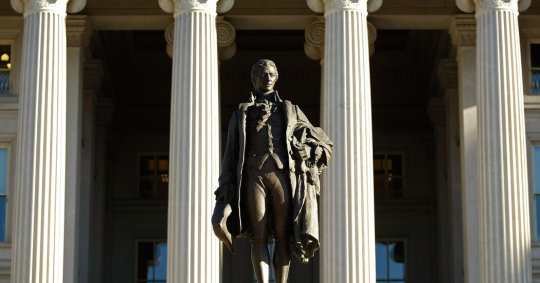
The evidence cited in the paper is not entirely new. But Jessie Serfilippi’s forceful case has caught the eye of historians, particularly those who have questioned what they see as Hamilton's inflated antislavery credentials. https://t.co/JaY0qM4EzB
— The New York Times (@nytimes) November 9, 2020
0 notes
Text
Serfilippi: “Prioritario intervenire sul torrente Arzilla”
Serfilippi: “Prioritario intervenire sul torrente Arzilla”
Serfilippi: “Prioritario intervenire sul torrente Arzilla”
Il consigliere della Lega ha presentato un’interrogazione in Consiglio regionale
FANO – “È prioritario intervenire sul torrente Arzilla che da anni necessita di una pulizia mai fatta in passato: bisogna prevenire i rischi per la sicurezza di intere zone di Fano. La Regione Marche è in prima linea per contrastare il dissesto idrogeologico.…

View On WordPress
0 notes
Text
L’opposizione: “Perché il sindaco e il M5S non parlano di sanità in Assemblea di Area Vasta?”
Fano (PU): “E’ passata poco più di una settimana dalla conferenza stampa in cui il sindaco sbatteva i pugni per dire che Fano è ricca di eventi e per lui va tutto bene, ma quando c’è da sbatterli veramente per denunciare quello che sta accadendo nella nostra città in ambito sanitario preferisce tacere e non prender parola. Bel modo di far politica e rappresentare i cittadini nelle sedi istituzionali predilette”. Ad affermarlo sono i consiglieri Luca Serfilippi (La Tua Fano), Stefano Mirisola (Forza Italia), Davide Delvecchio (Udc), Marianna Magrini e Gianluca Ilari (Progetto Fano) che aggiungono: “Ci chiediamo come mai il Sindaco Seri e il Sindaco di Fossombrone Bonci (appartenente al M5S) hanno preferito non proferir parola durante l’assemblea di Area Vasta dei sindaci della Provincia, che sono stati convocati dal Sindaco di Urbino, nonché presidente dell’assemblea, Maurizio Gambini”.
“Rimaniamo basiti – continuano i consiglieri – che di fronte alle denuncie dei sindacati e della associazioni che ruotano intorno al sistema sanitario, che chiedono tutti insieme di rivedere completamente il piano sanitario attuale (che sta provocando solo caos e tratta i pazienti come numeri), i due, insieme a tutti gli altri sindaci del PD, hanno preferito stare a guardare.Ci auguriamo che il Sindaco di Fano alla prossima riunione tra 10 giorni, si faccia portavoce di tutta la vallata del Metauro e del Cesano, scrivendo insieme al Presidente Gambini il documento che porterà in votazione. Dal canto nostro abbiamo più volte sollecitato un nuovo piano sanitario che rispondesse alle esigenze dei cittadini, pertanto porteremo nuovamente in discussione in consiglio comunale con un’interrogazione urgente il tema sanità, visto che il Sindaco non difende Fano nelle sedi opportune”.
from FanoInforma News http://ift.tt/2w5wiCK
via IFTTT
0 notes
Text
About Back2Life Fitness
Back2Life Fitness is a personal training and weight loss service based in Markham, ON. We specialize in weight loss, group fitness training, lean muscle gain, sports training, nutrition coaching, workout programs, and helping you improve overall fitness in the areas of strength, posture, and flexibility. Owner and head trainer Matthew Serfilippi was inspired to become a personal trainer after having struggled with weight throughout his early life. At Back2Life Fitness, we are not like other trainers because we actually know what clients are going through, and have a proven method to get you to your goals!
We provide boot camps and weight loss programs. We cater to people with busy, sedentary lifestyles who want to make a positive change in their lives. Whether you have health concerns to address or simply want to make an aesthetic change, we have the skill and experience required to help you achieve your goals!
Here at Back2Life Fitness, we don't rely on one-size-fits-all approaches to health and wellness. Every client starts off with a thorough fitness assessment with one of our personal trainers to better understand your goals, challenges, and current fitness level. Then we'll customize a complete and balanced workout plan that is specific in achieving your goals. For more information about our fitness center, contact Back2Life Fitness today!
0 notes
Text
Carloni e Serfilippi: “L’Ospedale Santa Croce continuerà ad erogare servizi a tutta la vallata”
Carloni e Serfilippi: “L’Ospedale Santa Croce continuerà ad erogare servizi a tutta la vallata”
Carloni e Serfilippi: “L’Ospedale Santa Croce continuerà ad erogare servizi a tutta la vallata”
Sotto accusa il sindaco Massimo Seri: “Fuori tempo e infondato il suo sussulto sulla sanità, dopo 7 anni di silenzio dall’inizio del mandato”
FANO – “Il primo cittadino di Fano, proprio il giorno in cui in città si è svolto un evento scientifico sul covid, alla presenza della Regione per parlare di…

View On WordPress
0 notes
Text
Serfilippi e Cancellieri al Pd: “Ecco perché l’Ospedale di Urbino è in difficoltá”
Serfilippi e Cancellieri al Pd: “Ecco perché l’Ospedale di Urbino è in difficoltá”
Serfilippi e Cancellieri al Pd: “Ecco perché l’Ospedale di Urbino è in difficoltá”
ANCONA – I consiglieri regionali Giorgio Cancellieri e Luca Serfilippi (Lega) rispondono in Consiglio Regionale all’interrogazione a risposta immediata presentata dai consiglieri del Partito Democratico Micaela Vitri e Andrea Biancani, relativa alla mancanza di personale sanitario nell’Ospedale Santa Maria della…

View On WordPress
0 notes